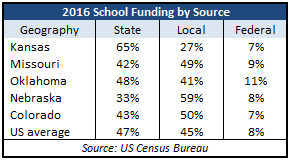If schools were ranked by debt and other financial measurements rather than achievement, Kansas would be a national leader in public education.
For all the caterwauling about public schools being starved for funding, the data from the U.S. Census Bureau for 2016 shows a different reality altogether. As reported by the Kansas Policy Institute, Kansas kicks butt in all the wrong categories:
- –Kansas has the 2nd highest growth rate in cash and securities since 2001 (284 percent)
- –Kansas has the 6th highest share of total aid coming from the State (65 percent)
- –Kansas has the 7th highest per-pupil spending on Capital Outlay ($1,946)
- –Kansas has the 8th highest debt per-pupil ($11,238)
Kansas may be only 8th in debt per-pupil nationally, but, as they say in the recording industry, there is a bullet next to its name. In 2017, Kansas set a new record of $6.1 billion in bonded indebtedness. Look for Kansas to climb the charts in the next ranking.
The 65 percent state share of school funding was tabulated before lawmakers added $1 billion or so to school funding in coming years. Look for Kansas to climb the charts in this category as well.

Says KPI President Dave Trabert, “Education officials prefer the higher State allocation [of funding] because local property tax increases would prompt citizens to scrutinize school spending practices.” Trabert adds parenthetically, “Legislators tend to look the other way because that’s the expedient way to get re-elected.”
The next governor may regret getting elected. Calculations by the Kansas Legislative Research Department estimates a $3.7 billion revenue shortfall over the course of the next four years, as a result of approved and proposed school funding increases. This shortfall presumes funds are not withdrawn from the highway department or from payments to the pension system, and that lawmakers comply with state laws on ending balances.
Says Trabert in something of an understatement, “Whoever wins in November will have some critical decisions to make.”

